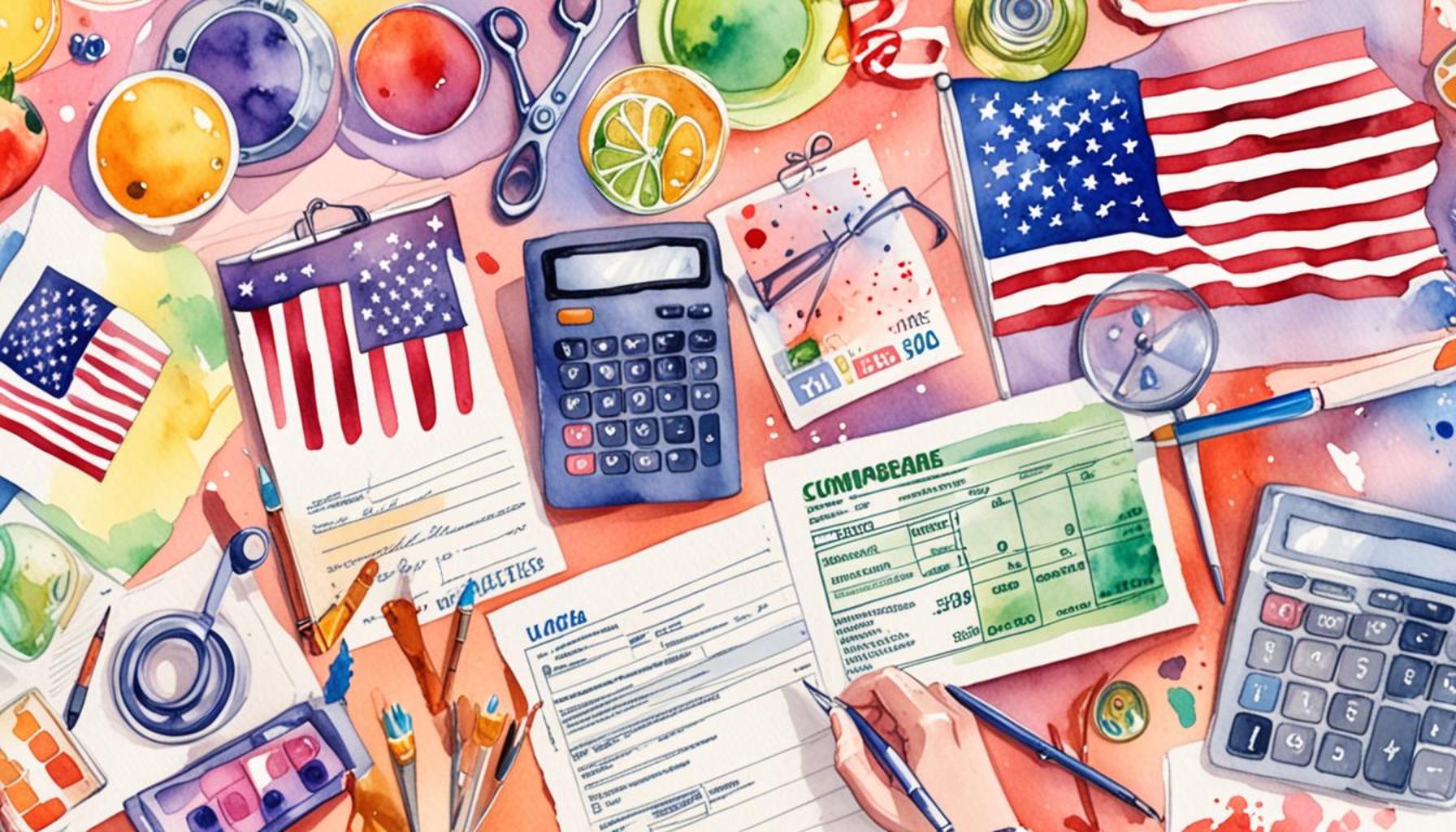Tax Incentives for Creative Industries: Stimulating Culture and the Local Economy

The Impact of Tax Incentives on Creative Industries
The creative industries are vital to the American economy, transcending mere visual appeal to become drivers of economic growth, social cohesion, and artistic expression. This dynamic sector encompasses a wide range of fields—including film, music, theatre, visual arts, and digital media—each contributing significantly to local and national economies. Given their importance, tax incentives have emerged as a financial mechanism that can further unleash the potential of these industries, catalyzing growth, innovation, and job creation.
Tax incentives can manifest in various forms, such as tax credits, deductions, and exemptions, all aimed at reducing the financial burdens faced by individuals and companies within the creative sector. This relief empowers businesses to invest more resources into their projects, ultimately leading to greater innovation and quality outputs. Below are several measurable areas that illustrate the positive impact of tax incentives:
- Job Creation: Tax incentives often encourage creative businesses to expand their workforce. By lowering production costs, companies are more willing to hire and retain skilled professionals in creative fields. A report showed that regions offering tax incentives for film production saw a direct correlation with job increases in related industries, such as set construction, catering, and transportation.
- Investment: With enticing tax benefits, states can attract significant investment into new projects. For example, the film industry in Georgia has flourished thanks to generous tax credits, bringing in billions of dollars of investment and enabling the establishment of a robust local infrastructure for filmmaking and talent cultivation.
- Cultural Preservation: Tax incentives foster initiatives that uphold and promote local traditions and heritage. Programs that support arts education, historical sites, and community-based art projects not only strengthen local culture but also enhance community pride and identity.
Several states have recognized the importance of tax incentives in boosting their creative economies. For instance, California’s Film Tax Credit has played an essential role in the resurgence of the film and television industry, stimulating production and creating over 50,000 jobs since its implementation. Meanwhile, New York’s Film Tax Credit has been instrumental in attracting big-budget films, reportedly generating over $9 billion in revenue for the state’s economy. Likewise, Texas’ Music and Film Incentives have transformed cities like Austin into cultural hubs, attracting festivals and a diverse array of artists, establishing the city as a key player on the national arts scene.
In conclusion, as legislative leaders and industry stakeholders navigate the complexities of the cultural economy, the significance of tax incentives cannot be overstated. These financial tools hold the potential not only to bolster the creative sector but also to enrich communities and preserve cultural narratives. By continuing to support and expand tax incentive programs, the United States can ensure a thriving future for its creative industries and the countless individuals they empower.
SEE ALSO: Click here to read another article
Unlocking the Potential of Creative Economies
As the creative industries evolve, the implementation of tax incentives has emerged as a fundamental strategy for nurturing these sectors while simultaneously stimulating local economies. Beyond financial allowances, these incentives have the power to shape cultural landscapes and promote artistic endeavors that resonate with communities. One of the primary aims of tax incentives is to make creative work more viable and sustainable, particularly in an era where funding is often limited.
The economic benefits of tax incentives extend beyond mere statistics; they foster a ripple effect that influences various facets of society. For instance, consider the film industry, which has been a focal point for tax incentives in states like Louisiana and New Mexico. By implementing generous rebate programs, these states have not only attracted high-budget films but have also created an environment where local talent can thrive. The jobs created are not limited to actors and directors; they extend to a myriad of support services such as costume design, sound engineering, and location management. A study by the National Conference of State Legislatures reported that every dollar of film tax incentive spent can yield up to $2.50 in economic returns.
Quantifying the Impact of Tax Incentives
To fully grasp the impact of tax incentives on creative industries, one must look at the nuanced effects on local economies. This can be broken down into several impactful areas:
- Enhanced Local Revenue: The influx of businesses in the creative sector typically correlates with a rise in local sales and property taxes. With more people drawn to regions that promote arts and entertainment, local governments witness an increase in consumer spending.
- Tourism Boost: Creative industries often serve as a catalyst for tourism. Cities known for their film festivals, art exhibitions, or music events attract visitors from around the globe, enriching local businesses—from hotels and restaurants to shops and transportation services.
- Encouragement of Innovation: By alleviating financial pressures, tax incentives encourage risk-taking and experimentation among local artists and creators. This not only leads to novel artistic expressions but also accelerates the emergence of unique cultural identities that bolster a community’s distinctiveness.
States such as Ohio and Michigan have also adopted comprehensive tax incentive programs aimed at film and television production, providing case studies that reflect how creative sectors can flourish when given the right support. Such initiatives have resulted in creative clusters forming, where synergies among various businesses lead to greater innovation and collaboration.
Ultimately, while the direct financial benefits of tax incentives are compelling, the broader cultural implications cannot be ignored. A thriving creative sector not only revitalizes local communities but also plays a pivotal role in creating a sense of belonging and pride among their residents. As cities across the United States continue to embrace these incentives, the challenge will be to ensure that they are structured to maximize both economic and cultural returns.
| Advantages | Description |
|---|---|
| Boosts Local Employment | Tax incentives can effectively stimulate job creation in the creative industries, providing new opportunities for local talent. |
| Encourages Cultural Innovation | By easing financial burdens, these incentives foster a vibrant atmosphere for cultural experimentation, leading to unique artistic expressions that enrich community identity. |
| Strengthens Local Economies | Creative initiatives attract tourists, thereby generating increased revenue for local businesses and enhancing the overall economic landscape. |
| Enhances Education and Skill Development | Support for creative sectors often leads to collaborative educational programs that develop skills in the community, providing long-term benefits. |
SEE ALSO: Click here to read another article
Creating a Cultural Renaissance Through Supportive Policies
The strategic use of tax incentives is proving essential not only for financial viability in the creative industries but also for fostering a wider cultural renaissance. As cities strive to redefine their identities and reinvigorate their local economies, a closer examination of the interplay between tax reliefs and cultural production becomes critical. Notably, sectors such as music, theater, fashion, and arts marketing are witnessing transformation, driving both local engagement and international recognition.
Case Studies of Successful Implementation
Exploring successful models from various states reveals how diverse initiatives can yield promising results. For instance, the city of Nashville, Tennessee—a global hub for music—has offered tax incentives for recording studios and film productions, thus attracting musicians and filmmakers alike. The Tennessee Entertainment Production Credit allows eligible projects to receive a rebate of up to 30% of eligible expenses incurred, encouraging an influx of talent and expertise. According to the Tennessee Department of Economic Development, the program generated over $78 million in economic impact within a single year, underscoring the correlation between arts funding and local prosperity.
Similarly, the state of Georgia has offered tax credits for film and television productions, which has resulted in significant economic revitalization. The Georgia Film Tax Credit, initiated in 2008, provides a 20% credit and has transformed Atlanta into the third-largest film production hub in the United States. The 2020 report by the Georgia Film Office recorded a whopping $9.5 billion in direct spending from the film industry, which has been instrumental in creating jobs and fostering ancillary businesses in hospitality, retail, and services.
Expanding Opportunities for Diverse Creators
Recognizing the potential for inclusivity, tax incentives can play a pivotal role in promoting diversity within creative industries. Local governments have begun to craft initiatives that specifically support underrepresented artists. For example, the city of San Francisco has introduced grants for artistic projects aimed at minority communities, which not only encourages participation but also enhances cultural dialogues. Programs like these can also attract younger audiences, embedding a sense of ownership within local culture—a crucial factor in maintaining relevance and sustainability.
Moreover, the involvement of philanthropic organizations and corporate sponsors often ties in closely with tax incentives. When companies contribute to local arts programs, they may be eligible for tax deductions that incentivize corporate social responsibility. This spotlight on collaboration can lead to innovative partnerships that amplify both cultural initiatives and economic returns. The results foster a healthy ecosystem where creativity is not merely an avenue for self-expression but becomes an engine for local economic development.
Challenges and Considerations
While the advantages are compelling, the implementation of tax incentives does come with challenges. Local governments must navigate budget constraints and ensure that tax breaks do not disproportionately benefit large corporations at the expense of small, local creators. Proper oversight and evaluation methods must be established to measure the effectiveness of these incentives in stimulating the local economy and preserving cultural integrity.
As the discussion around tax incentives for creative industries continues to evolve, it becomes increasingly vital for stakeholders—including artists, government officials, and community leaders—to collaborate. Their collective efforts in reproducing and sustaining cultural initiatives ultimately bear the potential to enrich not only their local economies but also the cultural fabric of the United States as a whole.
SEE ALSO: Click here to read another article
Concluding Thoughts on the Role of Tax Incentives in the Creative Sector
In conclusion, the strategic implementation of tax incentives for the creative industries has the potential to serve as a catalyst for not only cultural enrichment but also substantial economic growth. By investing in programs that support artists, filmmakers, musicians, and creators, local and state governments can foster unique cultural identities that attract tourism, drive job creation, and bolster community pride. The impressive economic figures from places like Georgia and Tennessee illustrate that the return on investment from these incentives can far exceed initial outlays, generating billions in direct spending and a multitude of ancillary benefits.
Furthermore, as creative sectors become increasingly diverse, the introduction of targeted tax incentives can help ensure that underrepresented voices are heard and valued within the cultural narrative. This focus on inclusivity not only strengthens the fabric of local culture but also positions cities as innovative and attractive destinations for a younger demographic. However, it is crucial to navigate the complexities of these programs carefully, ensuring equitable access that does not favor larger corporations at the expense of local creators.
As we look to the future, the conversation around tax incentives for creative industries will continue to evolve, requiring collaboration among all stakeholders, including artists, policymakers, and community members. Collaborative efforts can lead to a sustainable model of cultural production that resonates at both local and national levels, ultimately enhancing the economy and elevating the cultural landscape of the United States. The stakes are high, and the potential is immense; thus, it is imperative to maintain a concerted focus on fostering creative innovation through supportive policies.


